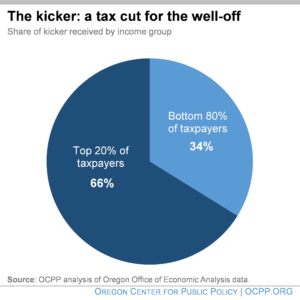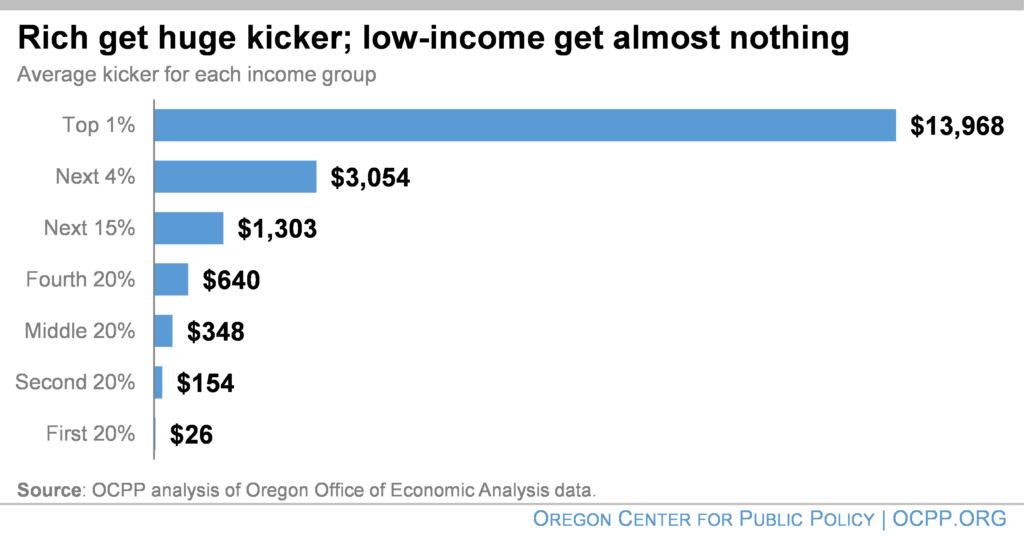The national oddity that is Oregon’s “kicker” law is on its way to hand huge bonuses to the richest Oregonians while compromising the stability of state revenues. The state’s elected leaders need to reform this flawed policy that takes away Oregon’s ability to invest in infrastructure and essential services, and thereby undermines the well-being of the vast majority of Oregonians. For the currently projected kicker, lawmakers should suspend it for the richest Oregonians and use the resources for important one-time investments. In the long term, lawmakers should refer to the voters a constitutional amendment to reform the kicker.
The kicker has proven to be an abject failure
The kicker is premised on the false assumption that state economists can foresee the future with extreme accuracy. Thus, it is no surprise that the kicker has struck Oregon at the worst of times.
The Oregon Constitution requires the state to send, or “kick,” unanticipated tax revenue back to taxpayers if revenue comes in 2 percent or more above what state economists forecast two years prior.[1] The kicker is not a result of taxpayers overpaying their taxes. Rather, it’s a forecasting error. The kicker is distributed to personal income taxpayers proportional to their taxes owed, prior to factoring in state tax credits. It is given as a tax refund or reduction in taxes owed in the next tax year.
The task before the state economists is a stunningly difficult one. They must predict the behavior of the global, national, and state economies years into the future and then correctly connect that to the revenues generated by millions of Oregonians. Over the last 18 budget periods, the kicker has been triggered 12 times. The last three budget periods have each had kickers.[2] This time the error is larger than ever before in dollar terms, at $1.4 billion.[3]
The kicker has kicked Oregon at the worst possible of economic times — in each of the last four recessions. It struck during the deep recessions of the early 1980s.[4] It hit again in 1991 amidst a recession; however, lawmakers rightly suspended it to address a budget shortfall.[5] It kicked during the recession of the early 2000s following the bursting of the Internet bubble. And it struck on the eve of the Great Recession in the late 2000s.[6]
The kicker undermines stability
By making it more difficult for Oregon to save for a rainy day, the kicker makes important public services such as education, public safety, and health care, vulnerable to economic downturns. The kicker makes essential services less stable. Oregon’s economy and revenue systems tend to outperform the national economy during expansionary periods and to fall hard during recessions.[7] Given this volatility, saving during good times to prepare for the bad times is critical.
In 2008, not long after Oregon had sent out a kicker totaling $1.1 billion, the damage of the Great Recession became apparent. State revenues began to dry up. The 2009 legislature, staring at a large budget shortfall, cut funding for all levels of education, services to families and children, and more.[8] Meanwhile, the highest-earning 1 percent of Oregonians received checks averaging more than $13,000.[9]
Saving unanticipated revenue would strengthen Oregon’s ability to withstand a recession. Saving during periods of economic growth helps the state avoid cutting important services during lean times. These services relied on by Oregonians are instrumental in helping to pull the state out of a recession. The kicker directly undercuts that goal.
The kicker is a big tax cut for the rich
The kicker is an automatic tax cut that largely accrues to higher-income Oregonians. The projected kicker will deliver about two-thirds of the tax benefits — a total of $933 million — to the highest-earning 20 percent of Oregon taxpayers. The biggest tax cuts will flow to those at the very top. As a group, the richest 1 percent of taxpayers will get $285 million.

The individual tax cuts for members of the top 1 percent will average nearly $14,000, about 40 times the $338 that the typical (median) Oregonian will receive.[10] The poorest 20 percent of Oregonians will get an average kicker of $26.

Legislature needs a short-term and long-term solution
The kicker is a fundamentally flawed public policy in need of reform. Lawmakers need to act in the best interest of Oregonians and make both a short-term patch and a long-term solution. First, in the current legislative session, lawmakers should suspend the portion of the projected kicker that would go to the highest-earning Oregonians and put it in reserves or address critical, one-time needs. Second, as soon as the 2020 session, lawmakers should refer to voters a constitutional amendment to reform the kicker.
Short-term action: Partially suspend projected kicker
The legislature has the power to suspend the kicker. The Oregon Constitution includes a provision that allows two-thirds of lawmakers in each chamber to suspend the kicker by altering the revenue forecast. This was done once before, during the 1989-91 biennium, and lawmakers should do it again. Lawmakers could leave in place the kicker for the majority of taxpayers and suspend it only for the highest income earners. Suspending the projected kicker for Oregon’s richest 1 percent, for example, would free up about $285 million to save in the Rainy Day Fund or invest in a pressing, one-time need.
Long-term solution: Send a constitutional referral to voters
The kicker is in the Oregon Constitution, so changing it requires a constitutional amendment. The legislature needs only a simple majority to refer a constitutional amendment, even in the case of legislation that would raise revenue.[11] While scrapping the kicker altogether is a reasonable alternative, lawmakers could instead reform the kicker in a way that truly serves the interests of the state and the vast majority of Oregonians. For example, lawmakers could pare back the kicker so only low- and middle-income taxpayers receive it. Alternatively, the kicker could give a flat, equal amount to all taxpayers and still leave significant revenue to be saved. In either case, the remaining unanticipated revenue would then be saved in the Rainy Day Fund or used to address critical one-time needs.
Conclusion
For too long, the kicker has failed Oregonians, creating an automatic tax cut that mainly benefits the well off, while making Oregon’s revenue system less stable. Lawmakers need to reform the kicker to truly serve the interest of the vast majority of Oregonians.
[1] This no longer includes the corporate income and excise tax revenues. The so-called “corporate kicker” is still calculated, but instead of being distributed to corporate taxpayers it funds K-12 education because of Ballot Measure 85 passed by voters in the 2012 election.
[2] The kicker was triggered in the 1989-91 biennium but was suspended by lawmakers. It is still included in the total here.
[3] Oregon Office of Economic Analysis, Oregon Economic and Revenue Forecast, May 2019. There have been larger kickers as a share of tax liability, but not in total dollars.
[4] Legislative Revenue Office, 2019 Oregon Public Finance: Basic Facts, at B1-B2. The nation was in a recession in 1980 and again from 1981 to 1982. US Business Cycle Expansions and Contractions, National Bureau of Economic Research.
[5] Ibid. at B2. Oregon was in recession from 1990 to 1991.
[6] Ibid.
[7] Josh Lehner, Oregon and the Business Cycle, Oregon Office of Economic Analysis, May 2016.
[8] Oregon Center for Public Policy, The Swing of the Budget Ax, July 12, 2010.
[9] The 2007 Kicker: Wrongheaded, Unjust, Costly, and a Federal Tax Increase, Oregon Center for Public Policy, October 2007.
[10] The median ($338 in this case) is different than the average of the middle 20 percent ($348) shown in the chart below.
[11] The Oregon legislature can use a “joint resolution” to refer to the voters a proposal to change the Oregon Constitution. Oregon Legislative Assembly, Form and Style Manual for Legislative Measures, 2019-2020 Edition, at p. 65. Joint resolutions are distinct from “bills.” Thus, the constitutional requirement that “bills for raising revenue” need a three-fifths majority of the legislature does not apply to joint resolutions, even when the joint resolution, if approved by voters, results in revenue being raised. See Oregon Constitution, Article IV, Section 26.






